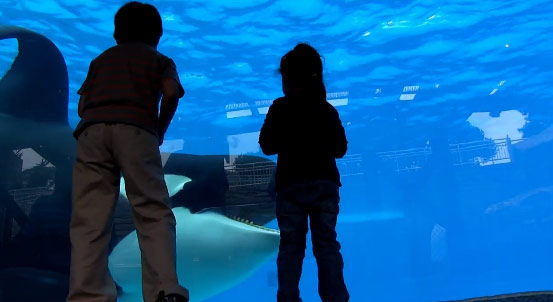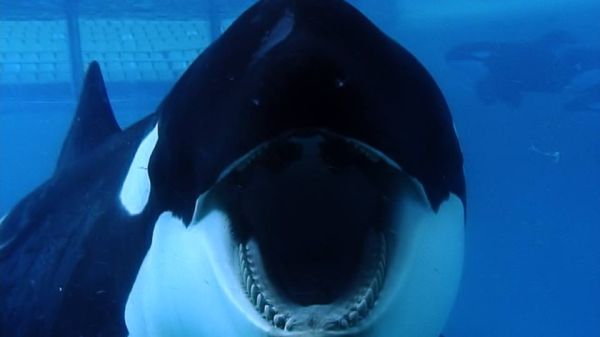
On March 17, SeaWorld Entertainment announced that they had decided to end all orca whale breeding programs, effective immediately. They’re making the move for pretty obvious reasons: the business needs to recapture some shred of public goodwill if they’re going to survive. Even if you haven’t followed SeaWorld’s actions since the release of the documentary Blackfish, it’s hard to think this is about animals and not money.
Blackfish was one of those rare pieces of advocacy that came at the exact right time and captured the public consciousness. It led to protests, intense international news coverage, celebrity-driven pushback, and plummeting stock prices. Since 2013, SeaWorld has tried everything to get Blackfish, PETA, and other activist groups off their backs (the irony!). They had orca handlers film awkward ads, they tried to discredit their attackers, and they admitted to embedding spies within the organizations they were at war with.
When it became clear that consumer behavior had shifted, SeaWorld began to distance itself from the orca shows that made the park famous, a few degrees at a time. After switching CEOs, they announced that they would be halting their orca shows in San Diego (not San Antonio or Orlando) in favor of less staged encounters.
But the hits just kept coming. In the past few months, the San Antonio park had three marine mammals die all below their average life expectancy, the company had to cop to their spying, and Tilikum — the whale at the center of Blackfish — was diagnosed with an incurable and deadly infection.

On the 17th, the other shoe finally dropped. SeaWorld announced an end to all captive breeding (along with a change to the San Antonio and Orlando shows). From the press release:
“As society’s understanding of orcas continues to change, SeaWorld is changing with it. By making this the last generation of orcas in our care and reimagining how guests will encounter these beautiful animals, we are fulfilling our mission of providing visitors to our parks with experiences that matter.”
The decision is perhaps less momentous than everyone would have us believe. First, the writing was on the wall — CEO Joel Manby had to do something big and, to date, SeaWorld’s response to Blackfish has been a series of half-measures. Second, the California Coastal Commission (a surprisingly mighty organization) banned the San Diego park from captive breeding back in October.
So, there it is. Things are changing. But orcas also live a long time (their mean life expectancy in the wild is 50.2 years), so don’t expect the killer whales at Sea World to vanish overnight. SeaWorld also clearly made an effort to get a few babies in the system before making this change. In 2014, they bred a whale that was five years below the average breeding age. The baby, Amaya, is now just over a year old. It’s tough to not be skeptical about a company who breeds an animal at nine years, when it typically breeds at more than 14 years (with outliers being around 11 years), just as they were coming under intense public scrutiny. This morning, on the Today show, Manby mentioned another whale that hasn’t been born yet.
An op-ed that Manby published in the L.A. Times committed to the fact that the orcas currently in SeaWorld’s care will remain in their care — which can be read as encouraging (they won’t be sold to another park) or discouraging (they won’t be released into open water enclosures, which is what PETA wants).
Manby’s L.A. Times piece is carefully crafted PR speak and makes no mention Blackfish or shifting consumer behavior — though he spoke about both things on the Today show.
“I would never admit that the care of our animals was poor,” the CEO said when Ronan Farrow asked if Blackfish was right all along. “There were a lot of factors that have changed people’s opinions, that film is one of them.”
With roughly 40 more years of anticipated killer whales in captivity at SeaWorld, the company clearly hopes that they’ve bought themselves some time to finally figure out a solid, sensible new business plan. They’ve also matched with a partner, the U.S. Humane Society. The USHS pairing also worries some conservationists. The organization has been criticized for the fact that their name is misleading (they don’t operate any shelters, which is a traditional role of a humane society), their CEO’s willingness to see Michael Vick owning dogs again, and their minuscule role in supporting shelters when 71% of the country thinks they are a pet shelter umbrella group.
Before this gets too complicated, let’s go back to the basics. Is SeaWorld’s decision a good thing? Sure. It’s hard not to be jaded, because the company had very few options, this seems like a financial/marketing decision, and SeaWorld raced to get a few more whales in the system once they saw the writing on the wall. But, the fact is, the era of captive breeding for killer whales is over and that’s a win for conservation.
Is it enough? That depends on your take. PETA won’t be satisfied until the whales are moved to sanctuaries:
“PETA has campaigned hard, and now there is a payoff for future generations of orcas,” PETA President Ingrid E. Newkirk said. “SeaWorld must open its tanks to the oceans to allow the orcas it now holds captive to have some semblance of a life outside these prison tanks.”
Manby’s op-ed made it clear that sanctuaries weren’t in the current plan (the company released the above artist rendering of what the new habitats might look like). Besides, SeaWorld isn’t worried about hardline activists. They just want to hit the sweet spot where the general public will finally stop listening to the hardliners and return to their parks. This might be it. Blackfish‘s director, Gabriela Cowperthwaite, seemed upbeat in a comment made to the Hollywood Reporter:
“Of course we want more because change should always be dynamic. But breeding, expanding killer whales into international markets, all these missives once sat at the center of their business model. And they’re willing to stop these practices immediately. This is paradigm shifting.”
One place where SeaWorld’s CEO definitely got things right came at the end of his piece, when he pointed out that we’re all to blame for the plight of endangered species worldwide. It might be seen as more buck passing, but it’s also undeniably true.
Americans and thoughtful people everywhere need to acknowledge these fundamental problems: More than 3,000 species are endangered, and hundreds are lost every year. Some scientists predict that, within a century, 50% of large mammals will be extinct.
Wild animals and wild places will continue to disappear — biologists call this “the sixth extinction,” comparable to previous cataclysms such as the ice age — unless humans awaken and take action.
To donate to orca conservation and study in the wild, visit the Orca Research Trust






